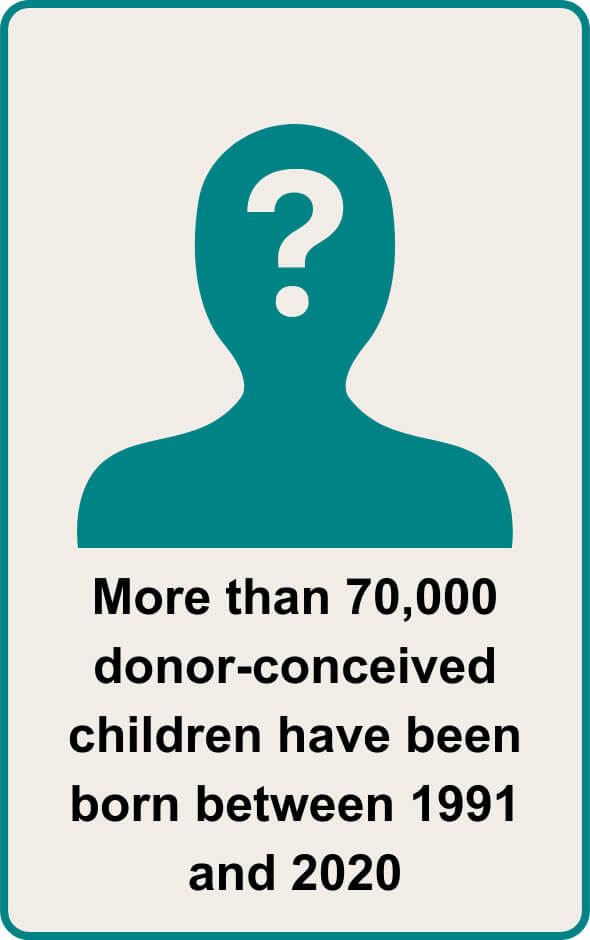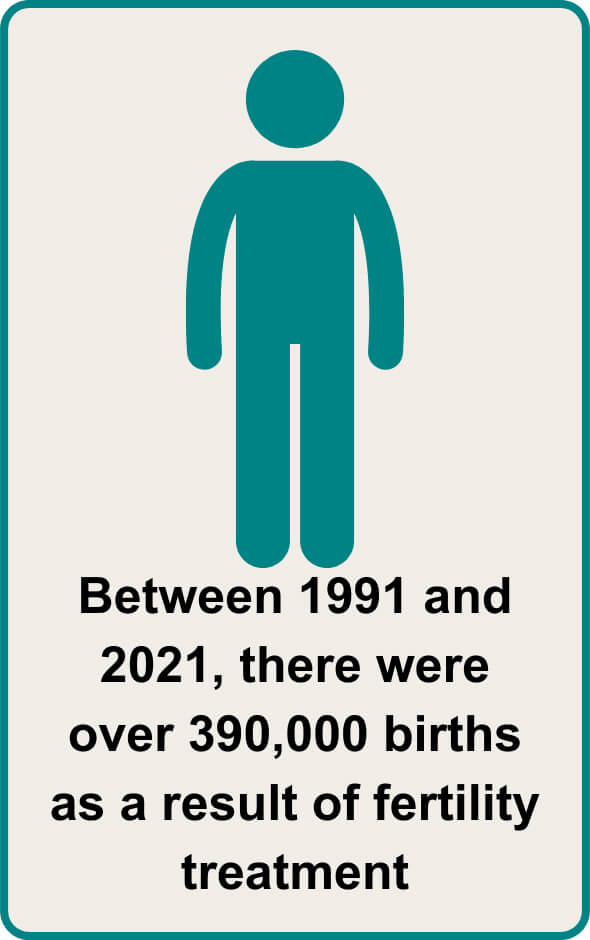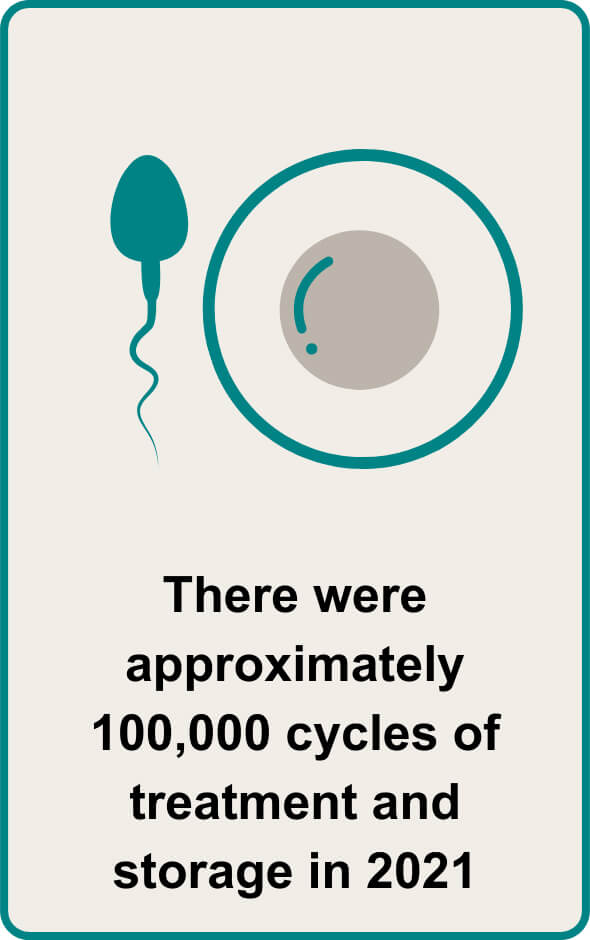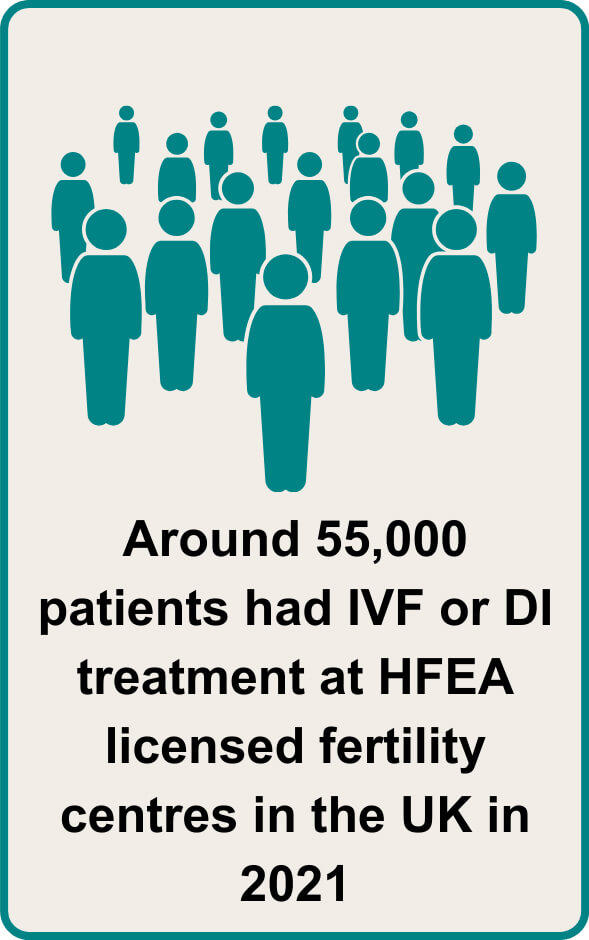The HFEA has launched its new Media Centre where you can find the latest news and information from us. Access it here.
IVF
Data from: Fertility treatment 2021: preliminary trends and figures
- Around 55,000 patients had in vitro fertilisation (IVF) or donor insemination (DI) treatment at HFEA licensed fertility centres in the UK in 2021.
- IVF cycles (fresh and frozen embryo transfers) increased to 76,000 cycles in 2021 from almost 70,000 in 2019 (+9%). DI cycles increased to 7,000 in 2021 from around 6,000 in 2019 (+22%).
- Average IVF pregnancy rates using fresh embryo transfers for patients aged 18-34 were 41% per embryo transferred, compared to 6% for patients aged 43-50 when using their own eggs in 2021.
- The use of private funding by patients across the UK aged 18-34 has continued to increase with 63% of IVF funded privately in 2021 compared to 52% in 2019.
- The average age of IVF patients increased to 36 years old and DI patients’ average age was 34 in 2021. The overall average age that women in England and Wales had children was 30.9, according to the Office for National Statistics (ONS).
- One cycle of IVF can take 3 to 6 weeks. (In vitro fertilisation (IVF))
Egg freezing
Data from: Fertility treatment 2021: preliminary trends and figures
- The number of egg storage cycles increased from around 2,500 in 2019 to over 4,200 in 2021 (+64%).
- Despite these large increases, egg storage cycles accounted for only 4% of all treatments carried out in 2021.
- Due to how the data is stored on our Register, we cannot provide accurate success rates for frozen egg cycles. This is because we cannot reliably link the age of the patient at egg freezing, which will have the greatest impact on success rates in egg thaw cycles, with when they had treatment. For these reasons, we recommend looking at the success rate for fresh IVF cycles with patients using their own eggs, even when considering egg/embryo freezing or thawing.
Donation
Data from: Trends in egg, sperm and embryo donation 2020
- Donor conception led to more than 4,100 births in 2019, accounting for 1 in 170 of all births and for nearly 1 in 6 births using IVF in the UK.
- The number of children born from donor sperm more than tripled from under 900 in 2006, to over 2,800 in 2019. This increase was driven by single patients, and patients in female same-sex relationships.
- More than 70,000 donor-conceived children have been born since 1991.
- Around 1 in 6 children born as a result of IVF treatment were conceived using donor eggs, sperm or embryos in 2019.
- The number of donor-conceived people in the UK newly eligible to request identifying information about their donor will rise from around 70 in 2022 to a maximum of almost 1,300 in 2024.
- By 2030, we predict there will be an average of one or two donor conceived children in every English state primary school. (Fresh plea from UK fertility regulator as monumental changes to donor anonymity law finally come to fruition)
- In 2021, there were 1,409 new egg donor registrations and 768 new sperm donor registrations. (Fertility treatment 2021: preliminary trends and figures)
About the HFEA
- The HFEA is the UK’s independent regulator of fertility treatment and research using human embryos.
- Set up in 1990 by the Human Fertilisation and Embryology Act, the HFEA is responsible for licensing, monitoring, and inspecting fertility clinics - and taking enforcement action where necessary - to ensure everyone accessing fertility treatment receives high quality care.
- The HFEA is an ‘arm’s length body’ of the Department for Health and Social Care, working independently from Government providing free, clear, and impartial information about fertility treatment, clinics and egg, sperm and embryo donation.
- The HFEA collects and verifies data on all treatments that take place in UK licensed clinics which can support scientific developments and research and service planning and delivery.
- The HFEA holds records of all fertility treatments and outcomes taking place in licensed clinics since 1991.
- The HFEA is funded by licence fees, IVF treatment fees and a grant from UK central government. For more information visit, hfea.gov.uk
Review date: 7 March 2026






